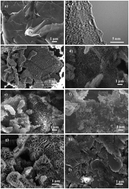A graphene supported polyimide nanocomposite as a high performance organic cathode material for lithium ion batteries†
Abstract
Organic electrode materials are promising and future candidates for applications such as cathode in green lithium-ion batteries (LIBs). Herein, a nanocomposite electrode comprised polyimide nanostructures on few layers exfoliated graphene (PI–FLEG) was developed via a simple in situ polymerization in well dispersed exfoliated graphene sheets. The electrochemical properties of PI–FLEG were significantly increased with the graphene additives and were utilized efficiently when compared with the pure polyimide. When employed as the cathode in LIBs, PI–FLEG can deliver a discharge capacity of 177 mA h g−1 at 0.1C. PI–FLEG retains 80% of its initial discharge capacity after 200 cycles at 0.5C. The significant capacity, good cycling performance and low resistance of PI–FLEG are attributed to the synergistic effects of the vertically grown polyimide on dispersed graphene sheets. This type of electrode may hold an insight for high energy density organic cathodes in rechargeable LIBs.


 Please wait while we load your content...
Please wait while we load your content...